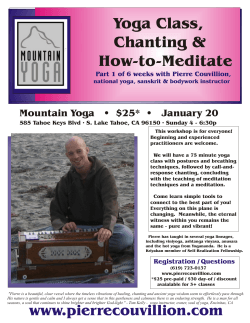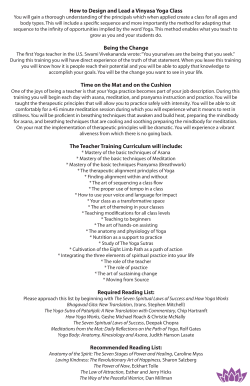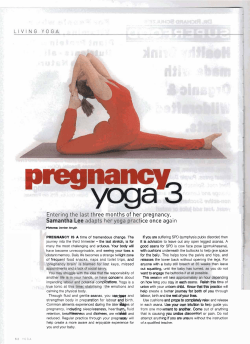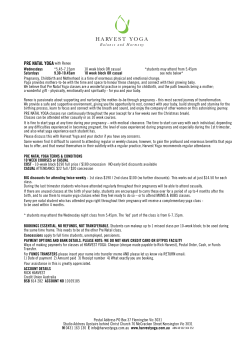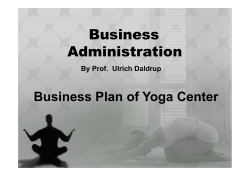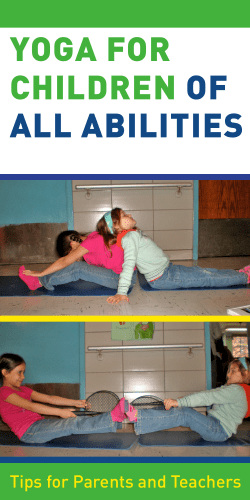
YOGA ED SAMPLE LESSON PLANS Pre-school Lesson Plan
YOGA ED SAMPLE LESSON PLANS Pre-school Lesson Plan Week 1: Unit One: Body Lesson 3 – Balance Inquiry: What is balance and off-balance? Discussion: Blocks Metaphor. Bring in three blocks for each child. Allow the children to experiment with balancing them one on top of another. Demonstrate that when the blocks are aligned and balanced, they are able to stand tall and strong. When the blocks are out of alignment and off-balance, they tumble. Stand up and apply the same principles to your body. Discuss tools we can use to help keep the body in balance. Time In: Introduce the song I’m A Rainbow – Yoga Ed Pre-school CD. Rainbow Breath Bring in a picture of a rainbow and make an origami rainbow (See Games) for the children to view. Invite children to breathe deeply and sit up tall like the extended origami rainbow. Coach them to breathe in the colors of the rainbow and to choose the color that helps them feel most balanced. Invite them to say words that describe how they feel when sitting or standing tall and balanced. Warm-up: Play Fly like a Butterfly (See Warm-up Activities) Yoga: Friend Story (these are all poses that require balance) On the tallest mountain, (mountain pose), there is a forest of trees. On one particular tree (tree pose), there lives a bird (bird pose). One morning, bird decides to visit her friend bear. She flies down to the valley to the cave (triangle pose) of bear. “Bear, oh Bear! Come out and play”, calls bird. Bear (bear pose) walks out of his cave. Together they travel to the nearby lake to find their friend flamingo (flamingo pose). “Would you play with us?” asks bear and bird. Flamingo is thrilled. (The teacher invites the children to suggest another animal that would like to join in the fun.) All the animals play together all afternoon splashing in the water. Game: Group Pose - Forest = Tree pose in a circle with everyone’s fingertips touching, like branches in a forest of trees. Coach children to notice how in just touching fingertips lightly, they can feel the support of their friends and use it to keep their own balance strong. Or Play Acorn Balance (See Games) Rest/Visualization: Rainbow Breath Rainbow Visualization (See Rest/Visualization) Class Project: Make and color a Balance Bird. Find the template for the balance birds in Games. Save the finished balance birds to use as a game in next weeks class. Notes: Pre-school Lesson Plan Unit One: Body Week 2: Lesson 3 – Balance, Part 2 Inquiry: How do I balance and maintain my balance? Discussion: Demonstrate balance using a simple two-sided scale. (You can make a homemade version by suspending two paper cups from a clothes hanger using string or yarn.) Discuss how when the scale is even on both sides, it is in balance. This applies to our bodies as well. Time In: Rainbow Breath Sit with legs crossed, eyes closed, back and neck long and straight. Breathe gently through your nose. Notice your inhalation and your exhalation. Is it even? Imagine you are a scale and you want to balance your breath. One side of the scale is your inhalation (breathing in) and the other side is your exhalation (breathing out). Notice if your inhalation and exhalation feel even. Like the scale, do you feel balanced? Warm-up: Introduce a tool for balancing – focus. Demonstrate how to rest eyes on one spot to help stabilize balance. Play Stop the Rock (See Games) Yoga: Earthquake Story (explore balance with stillness and with stresses added). Today, we shall visit our mountain again. Grab your backpacks, hiking boots, and sunhat. Let’s skip up the mountain (mountain pose). When we get to the top of the mountain there is an earthquake. Coach children to begin shaking from the tips of their toes to the top of their head. Direct them to stop shaking and return to mountain pose when the earthquake is over. “Is it hard for you to stay balanced when you are shaking? All the animals and plants on the mountain shake too. I wonder if it is hard for them to stay balanced.” Discuss different plants and animals that live on the mountain. The children choose some of these plants and animals and explore balancing in the corresponding yoga pose when everything is still and then explore balancing in the pose when everything is shaking. Some suggestions: tree pose, frog pose, flower pose, dragon pose, and many more. At the end, the children hike home and remove all their gear, drink lots of water and rest. Game: Play Balance Birds (use the balance birds made the previous week) (See Games) Or Play Circus Acts (See Games) Rest/Visualization: Rainbow Breath Rainbow visualization (See Rest/Visualization) Class Project: Balance Collage: Make a poster showing the outline of a body in a balancing pose. Invite children to draw themselves in their favorite balance pose. Then, cut out their drawings and glue them to the Balance Poster. Notes: K-2 Unit 1: BODY Week 1: Lesson 4 – Part 1: Your Center Inquiry: Where Is Center? Do I Have A Center? Discussion: Invite the children to find and point to the center of objects in the room. For example: a mat, a block, the clock, a ball, etc. Ask them to do the same on your body as you do different poses. Point out that the center stays the same even as you move. Have them find and feel their own center. Explain that this is the place where one comes together inside for the most strength and balance. Time-In: While sitting up tall, breathe from your center like a balloon. Feel yourself breathing. Warm-Up: Play Body Rockets Yoga: Rocking Horse / Boat / Peacock / Dragon / Sailboat Plank / Cobra / Shark / Bow / Rock / Down Dog Mountain / Tree / Shoulder Stand prep / Lying Twist Game: Circle of Friends (Games p. 136) or Mother’s Choice Visualization: Rest in Beanbag Bodies The Wisdom Tree visualization Class Project: Creative Drawing – Add a drawing to the Posture or Time-in Collage. Homework: Try feeling your center before you do things and see how it affects you. Show Sailboat to someone in your family. Remember to do both sides! Notes: K-2 Unit 1: BODY Week 2: Lesson 4 – Part 2: Your Center Inquiry: Can I Center Myself? What Does Being Centered Do For Me? Discussion: Review the concept of center and discuss the homework observations. Pebble and Water Metaphor Time-In: Teach Dog Breath (cooling) or Bunny Breath (cleansing) Warm-Up: Play Balance Bird or Stop the Rock Yoga: (Same poses as last lesson.) Rocking Horse / Boat / Peacock / Dragon / Sailboat Plank / Cobra / Shark / Bow / Rock / Down Dog Mountain / Tree / Shoulder Stand prep / Lying Twist Refine Sailboat and Shoulder Stand prep Game: Play Dogs and Snakes Visualization: Rest in Beanbag Bodies Meeting a Friend visualization Class Project: Creative Drawing - Add drawings to Posture or Time-in Collages Homework: Try speaking and walking from your center all the time. Write the word center on a card or paper and keep it in your pocket as a reminder. Practice Mountain pose each morning. Notes: G3-5 Unit 2: MIND Week 1: Lesson 3 – Part 1: Feelings Inquiry: What Are Feelings? How Do They Work? Discussion: Introduce the Feelings poster. Discuss any questions about emotions. Ask the children to identify how they are feeling today. Explain that yoga helps one notice what one is feeling. Just observe and allow it. Demonstrate resistance and non-resistance. Explain that feelings are part of all of our lives but suffering only happens when we resist how we feel or what is true. Rocks and Feelings Metaphor Time In: Observe and listen to your feelings. Allow them to just be there or to flow through you on your breath. Allow them to have a color, shape or texture. If you are not sure what you are feeling, breathe and relax, paying special attention to any tight places. Game: Play The Grouch Monster Blues Warm-Up: Review Sun Salute C. Yoga: Practice Push-ups. After Standing poses, demonstrate a challenging Twist. Explain how twists wring out toxins from organs and have a cleansing effect. Demonstrate with a wet rag or sponge if you like. Remind the class to drink plenty of water especially after twists. Do an Inversion to finish. Partner Play: Review and practice basic partner poses focusing on Resistance. Coach kids to use resistance to move slowly and gracefully together. Visualization: Rest pose Color Shower visualization Class Project: Journal Writing – Write about a situation in which you feel angry or sad. Allow yourself to experience how you feel about it. Can you let it go now? Can yoga help? Do you have any new ideas about how to deal with the situation? Homework: Practice a Twist (both sides) for a few minutes everyday. Notice when you are resisting in the pose, creating struggle, and when you are allowing, breathing and non-reactive. Can you feel the difference? What is your thinking when you resist? What is it when you allow or explore? Notes: G3-5 Unit 2: MIND Week 2: Lesson 3 – Part 2: Feelings Inquiry: Do I Know What I’m Feeling? Do I Allow My Feelings And Then Express And Release Them? Do I Use My Feelings To Help Me Get To Know Others And Myself Better? Discussion: Discuss homework observations. Teach the Eagle Wisdom Pose. Explain that this is a great pose for wisdom because it links your mind and your heart. Use it to center and balance yourself if you feel confused, scared, angry or sad. Time In: Focus on and accept what you are feeling and breathe. Don’t try to change or fix it. Just observe it. Warm-Up: Do a warm-up focusing on the heart and the breath. Demonstrate how to allow poses to unfold on your breath from your inner body and awareness. Coach non-resistance – don’t force tight places. Use finesse in thinking, breathing and doing. Yoga: Design a sequence that combines poses this group has been working on. Include a Twist and Inversion. Do the poses as a flow. Game: Play Cloud Jump Visualization: Rest pose Heart Mail visualization with music to enhance. Class Project: Creative Drawing – Add a drawing to the Heart Collage. Homework: Practice three poses in a flow everyday. Do them at different times of the day and when you are in different moods. Write about your experiences. Notes: *Directions for the Eagle Wisdom Pose: Cross legs or feet. Cross the arms in front of you at the wrists, turn the thumbs down, clasp the hands, interlacing the fingers, fold the hands under and bring them to your chest at your heart. Touch the tongue to the roof of mouth. Close the eyes and breathe into the heart, remembering someone or something you love. G6 – 8: UNIT 1: Week 1: Introductory Lesson – Part 1: What Is Yoga? Inquiry: What Do I Know About Yoga? Discussion: 1. Meet the students and learn all their names. Play Spider Dance. Ask what they’ve heard, think or know about yoga. Tell them a little about yourself and your background. Share with them why you love yoga and what it does for you. 2. Explain the concept of yoga as a way to link with one’s self and to develop awareness, strength, flexibility and balance, both physically mentally. In yoga class, unlike all your other classes, attention should be on oneself and one’s inner experience. You will learn not only yoga poses that enhance your coordination and health; you will learn tools that you can apply to your life. Give examples and use Blocks Metaphor. Time In: Explain the structure and order of class. Do a short Time-In. Invite the kids to listen to their breathing, or to feel their heartbeats. Warm-Up: Do a sitting warm-up sequence. Discuss what makes yoga different from other exercises: focus is on the breath, and attention is on process. Yoga: Demonstrate yoga poses such as: Down Dog / Up Dog / Triangle / Warrior / Shoulder stand and their adjustments. Explain what adjustments are for and that teachers will always ask permission before adjusting a student. Teach: Down Dog / Waterfall / Tree / Triangle / Bridge / Twist Partner Play: Teach one partner pose such as See-Saw / Elevator / Rooftops. Visualization: Demonstrate and explain that the final pose of every yoga class is called Rest. Coach students to lay back, close the eyes and do nothing. Test whether they are relaxed by making sure their arm or leg is limp if you lift it. Do a short visualization. Class Project: Hand out file folders for storing work, and have students personalize the covers using markers or other materials. Notes: For this introductory class, explain that the traditional way to end each class is to take a moment to acknowledge our selves and each other. Suggest an appropriate way for everyone to do that together, or invite students to create or choose one. You may want to say something such as Peace or Unity or simply: I thank myself and I thank all of you. G6 – 8: UNIT 1 Week 2: Introductory Lesson - Part 2: Assessment Inquiry: How Strong, Flexible, Balanced, Focused, Attentive, Aware and Creative Am I? Discussion: Explain that assessment is a form of measurement. Today we are measuring things about ourselves like strength, focus and balance so that we can chart our own progress and be responsible for our own work and goals. Our job is to follow directions, and to do our best. There is no right or wrong. Each one of us is different. Yoga is not a competition. It is about being okay with who you are, and working with yourself lovingly to make changes in any area that you choose. Time In: Bear Breath – Have students record how many counts they can breathe in and out. Repeat for several rounds. Also measure how long each student stays sitting still and inwardly focused. Give kinesthetic imagery or affirmations to help them. Warm-Up: Sitting stretches – Measure spine flexibility. Teach Sun Salute C, focused on following directions, body awareness, memory, coordination, and grace. Yoga: To measure posture, body awareness, coordination, concentration and ability to apply directions, use 3-4 of the following poses: Mountain – posture and alignment Rag Doll – hamstring / leg flexibility and strength Down Dog – leg / shoulder flexibility and strength Push-ups – arm / upper-body strength Cobra – upper body strength and flexibility Warrior – leg strength and concentration Triangle – hip flexibility and leg / torso strength Tree – balance and focus Twisting Star – torso / hip / shoulder flexibility Can Opener – hip / back flexibility and concentration Bridge – hip / back flexibility and leg strength Shoulder Stand Prep – coordination, flexibility, strength, Partner Pose – ability to apply coordination working with another Visualization: Conscious relaxation. Use Balloon Breathing or color imagery. Class Project: Creative Drawing – Give each student three pieces of paper and ask them to draw a house, a tree and a person. Homework: Write down your questions, concerns and goals for yoga class. Notes: MIDDLE SCHOOL MS Unit I: Physical Health Lesson 2: Alignment Week 1 Time-In: Sit up tall in a comfortable cross-legged position. Close your eyes and go inside. Be curious and pay attention to what’s happening inside you. Allow your torso to lengthen and invite your breath to become slow and full. Simply observe your breath as it comes in and as it goes out. Each inhale brings new energy and life force; each exhale takes away what is not useful. Imagine now that on each inhale, you breathe in light and on each exhale, you release stress. Breathe in beauty and breathe out tightness. (2-3 minutes) Note: Bring in a plumb line to demonstrate alignment. Sit up as straight and tall as you can. Now bring your awareness to your skeleton. Feel your VERTICAL - imagine a plumb line that runs through your center aligning you with sky and earth. Imagine you are being pulled gently in opposite directions - up from the top of your head and down from the base of your spine. Let your breath deepen and bring your hands halfway between your knees and your hips. Slide your shoulder blades down your back and hug them gently together, bring the sides of your neck back until you feel your head above your shoulders and your shoulder heads directly above your hips. Your skeleton now easily and effortlessly holds you upright. Your muscles, organs, nervous system, senses and thinking can all relax. Breathe deeply, go inside, feel your being… still… balanced…quiet.... spacious. (Allow 2 -4 minutes) Discussion: • Display skeleton model or skeletal system poster. Note the length and curves in the spine. Identify the primary curves in your own spine. • Identify boney landmarks. Include spinal vertebrae (cervical, thoracic, lumbar), sacrum, hipbones, collarbones; shoulder, knee, wrist and ankle joints. • Review habitual posture and its impact on the body and breath. • Discuss ways that Mountain pose is the blueprint for almost every other pose in yoga. Experiment: • Practice rounding and arching, extending and bending while seated. How do you feel each way? How is your breathing, your energy? What is happening to the organs and the bones as we slump stretch or stand tall? • Find a partner and coach each other on alignment first while seated then in Mountain pose w/feet hip distance. Use boney landmarks in your coaching. Remind them that developing new and healthy habits takes practice and PATIENCE and the long-term health benefits are worth it! Warm-up: Mountain w/feet hip distance, Mountain w/wrists at shoulder height Extended Mountain w/hands shoulder width apart, bend wrists like handstand Standing Forward Bend w/knees bent, torso on thighs and fingers interlaced behind back Roll up to Mountain – carry Mountain pose alignment through all poses Yoga: ½ Sun Salute Plank, align wrists/shoulders and shoulders/hips/ankles Plank, Cobra, Down dog (5x) Sun Salute A (3x) Go to wall Triangle, Warrior II (stand with back against wall for alignment) Crescent, Warrior I (stand with back heel against wall) Handstand Prep Tree King Arthur pose – in deep lunge with one shin up wall Camel facing wall Reclining leg lifts Shoulderstand Prep Reclining Twist Rest Visualization: As you close your eyes, bring your awareness to your skeleton. In your mind’s eye, find the same plumb line from Mountain pose. Feel the length of your spine, extending and completely supported. Music: During seated forward bends or just during rest, House Made of Dawn by Coyote Oldman Name Homeroom Date Homework Handout: Skeletal System Color in each labeled component of the skeleton below. Show all colors used on the key. Name Homeroom Date Homework Handout: Alignment Self Portrait Draw a before- and after- self-portrait of your own alignment. It can be just a line or stick figure. Use a mirror! 1. “BEFORE” is YOU, sitting or standing at the bus stop, washing dishes, doing homework, etc. 2. “AFTER”- is YOU, after putting all the principles of alignment into practice. BEFORE AFTER MS Unit I: Physical Health Lesson 2: Alignment Week 2 Time-In: Sit up tall in a comfortable cross-legged position. Close your eyes and go inside. Be curious and pay attention to what’s happening inside you. Allow your torso to lengthen and invite your breath to become slow and full. Simply observe your breath as it comes in ... and as it goes out. Each inhale brings new energy and life force; each exhale takes away what is not useful. Imagine now that on each inhale, you breathe in light and on each exhale, you release worry . . . Breathe in intelligence and breathe out negative thoughts. (2-3 minutes) NOTE: Students come to standing in Mountain. Come to standing. Bring your feet hip width distance. Extend all ten toes up toward the sky. Look down at your feet make sure they are parallel and lift up on your kneecaps to engage the quadriceps. Lift your heart and extend your tailbone towards the ground. The heads of your arm bones should come up so your side body lengthens. Bring your shoulder blades onto your back. Soften the front ribs. Bring your hands to your heart and close your eyes. Feel what it’s like to be perfectly aligned. Shift your weight forward, shift your weight back and then find that sweet spot that belongs to only you. Slowly open your eyes. Discussion: • Review alignment and the body using skeleton model or skeletal system poster. • Review habitual posture and its impact on the body and breath. • Collect homework from previous week. Share posture self-portraits with class. • Review Mountain pose as the blue print pose for all other poses. Experiment: • In today’s class let’s find Mountain pose in all of our poses. Let your bones support you. Hug your muscles around your bones and feel the lightness that action brings to the body. Warm-up: Mountain w/feet hip distance, Mountain w/wrists at shoulder height, turn palms up ½ Sun Salute Down Dog Yoga: Plank, Cobra, Down Dog Plank, Low Plank, Up Dog, Down Dog Sun Salute A (3x) Triangle, Warrior II Go to wall Crescent (back heel to wall), Warrior III (back foot on wall) Standing Split, Standing Forward Bend Handstand Standing Big Toe Pose (use belt around foot so spine is long) Down Dog, Shark (hold block between hands, shoulder blades on back) Bow, Down Dog, Child’s Boat, Down Dog Reclining Twist Rest Visualization: Ideal Self Breathe in peace and safety and allow it to melt everything else away… Imagine that even your body or brain melt away until all that’s left is just your essence. Your essence may be a color or just a skeleton or light or energy. Whatever forms your essence takes, take a few moments to get comfortable. Notice the difference in how you feel. Can you define it? Feel it deeply and let a word or a name come to you… Now as you watch, invite your essence to take the form of the Ideal You – create an image of you as everything you want to be. See yourself exactly as you would like to be. Then observe how you look… how you move… how you’re dressed and how you express yourself. How is it similar to you? How is it different? When you are ready, become your Ideal Self and notice how it feels. How do you feel on the inside? What kind of thoughts do you have? How does your body feel when you move? How does the world look through these eyes? As your Ideal Self, think about your current life and concerns. Can you see them now from a new perspective? Do the same issues or problems seem as important? Can you see something you can let go of? Something you can forgive or understand that has been bothering you? Think about how you could change things so that your life would be more loving, more fun, more fulfilling. When you are ready, thank your Ideal Self and your Real Self. Take a deep breath, wiggle your fingers and toes, stretch, roll to one side. Take a moment to embrace anything valuable that got from this experience. Music: After a strong yoga practice, rest with Sanctuary by Riley Lee Quiz: Skeletal System Quiz Name Homeroom Date Skeletal System Quiz Fill in the missing labels on the skeleton below. 1. 2. 3. 4. 5. 6. 7. 8. 9. 10. Alignment Relay There are two objectives to this game: 1. To finish first. 2. To do the relay the most like a yogi – quietly, safely, respectfully Divide class into teams. Each team chose a Captain. Captain: Please read each numbered instruction OUT LOUD. Upon completion of each task, get teacher approval before moving on to next number: 1. Starting at the window side of the room, do a line of triangle poses. The first person starts with their left heel against the wall and does triangle. The second person puts their left heel at the first person’s right toes and does triangle. The third person does the same, and so on, until you have a line to the other side of the room or ALL the players are in the triangle line (whichever comes first). 2. Make a list on the black board of seven things in the room that have a straight line in them. If the other team has written words down, you cannot repeat anything they wrote. 3. Get six yoga blocks out of the cupboard and stack them (the long way) from the floor toward the ceiling, then count to three together. If the stack tumbles before you reach the top or before you count to three, start over. 4. Hold hands and make a big circle. Step backward until circle is very round. Step forward into the middle - raising held hands high in the air. Then step back into a wide circle again. Do this three times (Captain count). Stay ALIGNED and IN SYNC, use finesse and be careful not to step on toes or squish anyone. 5. Get a blindfold off the teacher’s desk and put it on one volunteer from your team. Have that person spread his/her arms wide, then try to touch his/her nose with his/her right pointer finger. If the person misses, then have him/her try again. Repeat this motion with the left pointer finger. 6. Captain, do a Down Dog and have everyone on the team coach you into perfect alignment. Show it to the teacher when the alignment is right. 7. Count the vertebrae on the skeleton at the black board. Write the total on the board and circle it. 8. Stand in a “train” with each person’s hands on the shoulders of the person in front of them. Have the first person in the line wind around and put his/her hands on the shoulders of the last person, forming a circle. Sit down in the circle, put your hands palms together ABOVE your head and say “Victory!” The End ☺ HIGH SCHOOL UNIT TWO: WELLNESS Week 10: Yoga Mind-Body = Healthy Lifestyle = Awareness of HOW Anonymous: How you do anything is how you do everything. John Friend: Advertising agencies and the media inherently define what the most popular look and image is, and we then often use this definition as a measuring standard for ourselves. Many times this arbitrary standard sparks self-hate and a war with our body when we feel that we are far from what it takes to be “attractive” or “popular”. B.K.S. Iyengar: Before we can find peace among nations, we have to find peace inside that small nation which is our own being. Time-in: Sit comfortably in your vertical alignment. Close your eyes. Breathe. Settle into the earth through your sit bones on your exhale. On your inhale, feel your spine rise up and elongate. Allow your head to rise toward the sky. As you breathe, imagine your spinal cord becoming energized while your joints, muscles, skin and thoughts relax. Become aware of any tension or stress you are holding and as you breathe, let it go. Let go of the outside and connect with the inside. Bring your awareness into your heart. As you breathe, assume that you are whole, perfect and complete just as you are. Notice if any objections to that assertion arise and just observe what they are. Now tune out those voices and shift your awareness back to breathing into your heart and feel your goodness, your wholeness, your humanity, your vitality. Breathe in love and light and breathe out love and light. Appreciate yourself, trust yourself, love yourself. From this place, imagine HOW you could to do your yoga today. Choose to do it as a celebration of who you are, as a gift to yourself, as a way to feel good and enjoy yourself. Mind-body science has proven that HOW we think, How we do things, How we relate to life is a vital component of health. Notice today HOW you do your yoga. Do you do yoga to punish, fix or improve yourself? That attitude perpetuates the lie that there is something wrong with you. Do you do yoga from your heart to love and support yourself? Can you have fun in your efforts, be kind to yourself, laugh at your limitations, enjoy your body and the amazing vessel that it is, energize, unwind, explore and create space inside yourself? That attitude is the wellspring and essence of health. Discussion: • Reflect on Time-in and the quotations o Notice your basic relationship to your body and your life (attitude, thoughts, feelings). Are you at war or peace? o Notice HOW you are in your life, how you do things. (force or finesse?) o Discuss the impact of attitude and intention on results, on health • • Discuss answers to homework question: Why practice yoga? o Write down student goals o Discuss How to achieve them in a healthy way for mind and body Review yoga principles (the HOW of yoga) as what works for health o Breathing – the focus / smooth and deep sounding breath / spacious o Attitude – adventurer / fun in the process/ supportive o Alignment – elongated / balanced by opposition / safe o Action – with finesse / graceful / joyful Warm-up: Rock – Cat - Dog Rag doll Rocking Horse from standing to standing Core strengtheners Plank – push-up – Up-Dog – Down Dog Yoga: Sun Salutes Focus on smooth transitions Standing poses Balance poses - handstand / headstand / arm balance Shoulder and hip openers Back bends Twists Partner poses Rest/ Visualization: Relax…Let go… allow yourself to be loved and supported by the floor, by the space, by each other, by my voice…by life itself. With each breath, receive and refuel… Think of a child that you love. Imagine being with them and feel how much they mean to you. Now, imagine that they are scared or sick or sad and help them… Notice how you are with them – it may be patient, caring, protective, consoling. And notice how it makes you feel to be able to be that for them. Be that for yourself. Be that for others. Music: Embracing the Wind by Kevin Kern Homework: • Continue a daily Time-in and yoga practice for home – keep a record and journal • Read Life Strategies for Teens pages 13 – 49 • Do workbook pages 3 - 22 UNIT TWO: WELLNESS Weeks 11 – 12: Systems of the Body Jay McGraw: The world works as a system; all you have to do is learn that system and then work it, and you, too, will get what you want. Christina Sell: I realized that if I practiced in a way that ignored my pain with harsh and critical internal dialogue, I would be perpetuating the same war that I had known my entire life. I realized that if I could learn to slow down, to pay attention to my alignment, to honor my pain and respect my limits, then I could make my yoga into an offering of peace. Time-in: Sit comfortably in your vertical alignment. Close your eyes. Breathe. Settle into the earth through your sit bones on your exhale. On your inhale, feel your spine rise up and elongate. Allow your head to rise toward the sky. As you breathe, imagine your spinal cord becoming energized while your joints, muscles, skin and thoughts relax. Become aware of any tension or stress you are holding and as you breathe, let it go. Let go of the outside and connect with the inside. Bring your awareness into your heart. As you breathe, allow yourself to receive the gift of your health, your wholeness and your vitality. Become present to the miracle of your body and all that it does for you everyday. Breathe in health and breathe out health. Now simply allow your breath – letting it guide you to greater relaxation and awareness. Imagine your breath spreading a soft white light through your entire skeleton, both soothing and energizing your bones. Then let that light move into your nervous system and brain. It softens your face, clears your mind and soothes your senses. Your eyes and jaw and mouth and neck relax. Through your circulatory system now, that soft light enters every muscle and cell. It nurtures your heart and cleans your lungs. It soothes your belly and energizes your digestion. You experience moving to a new level of health, balance and awareness as the light revitalizes every system in your mind and body. It feels good and brings with it a new understanding about how to honor yourself and maintain your health. Notice any insights or thoughts that occur to you about your habits and invite this deeper knowing to guide your choices from now on. Discussion: • Discuss homework reading. o Connect Yoga Principles to Life Laws = what works o Review why how we do yoga is so important = a way of being • Review Systems of the Body and how yoga impacts them and our health: o Skeleton / Alignment = integrity = stability = flow o Muscles / Joints = balanced action = grace = no injuries Experiment and explain working with muscles / ligaments / tendons / joints o Nervous System / Endocrine System = mental and emotional balance o Respiration = lung health = energy flow = elimination of toxins o Circulation = heart health = strength and stamina = flow and vitality o Digestion = inner organ health = nourishment and elimination = strength and stamina = clarity of processing How Yoga affects us: o Forward bends Calm, quiet and introvert Stimulate and balance endocrine system and internal organs o Standing poses Strengthen, ground, energize, focus Strengthens muscles, joints, circulatory system o Balance poses Focus, integrate, stabilize Strengthen core muscles, develop coordination, balance nervous system and integrate both hemispheres of the brain o Twists – Cleanse, de-stress, unwind, integrate both sides of brain Stimulate and balance digestive system and nervous system o Backbends – Energize, extrovert, open Stimulate spine, hip, shoulder flexibility and respiratory system o Restorative poses – Nurture, relax, recharge, unwind Balance nervous system and all organs, stimulate creativity and healing Warm-up: Focus on foundation and leg alignment Mountain pose Forward bend with active legs Squat then up to Waterfall Blown Palm Star – Twisting Star Game: Stand Your Ground – Hold Your Center With a partner, stand face to face about 2 feet apart. Bend knees slightly to ground yourself and bring hands up in front of you, palm to palm to your partner. Try to push your partner off their grounding as they try to push you off yours. You can also play it from a lunge position and try to pull your partner off center. Partners stand with their right feet next to each other, pinky toes sides touching. Then, both step back with their left legs into a lunge. Get grounded and then grip right hands or wrists. Partners try to pull each other off center without being pulled off them selves. This game helps students experience being strong, grounded and centered without being stiff, tense or resistant. The trick is to remain solid in the lower body while being relaxed, flexible and non-resistant in the upper body. Yoga: Partner warm-ups Sun Salute B Dancing Warrior Dolphin Forearm balance Crow Dragon with knee down – twist and backbend and thigh stretch Pigeon Rocking horse Back bends Plow Fish Rest: Use Constructive Rest Pose and/or give restorative pose options Music with visualization: Relaxmore, A Guided Deep Relaxation by Jillian Pransky Homework: • Continue a daily Time-in and yoga practice for home – keep a record and journal • Research and review the systems of the body. Decide which system in your body is the weakest and design a short yoga sequence (3 – 5 poses) that will strengthen, heal or balance it. Be prepare to demonstrate and explain it to the class or write it down to be handed in. • Read Life Strategies for Teens, Life Law #1 pages 51 - 65 • Do workbook pages 25 - 43
© Copyright 2025
